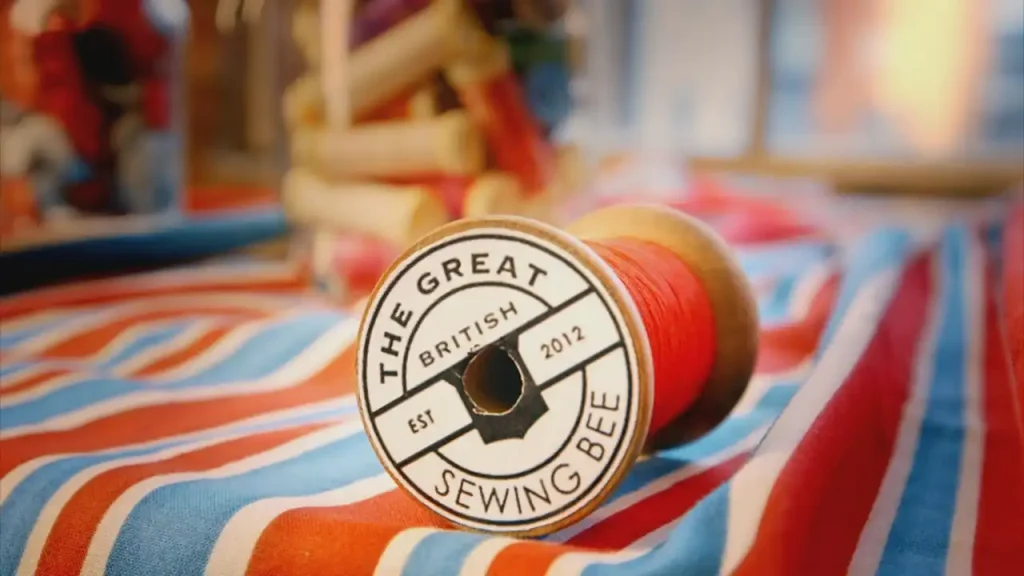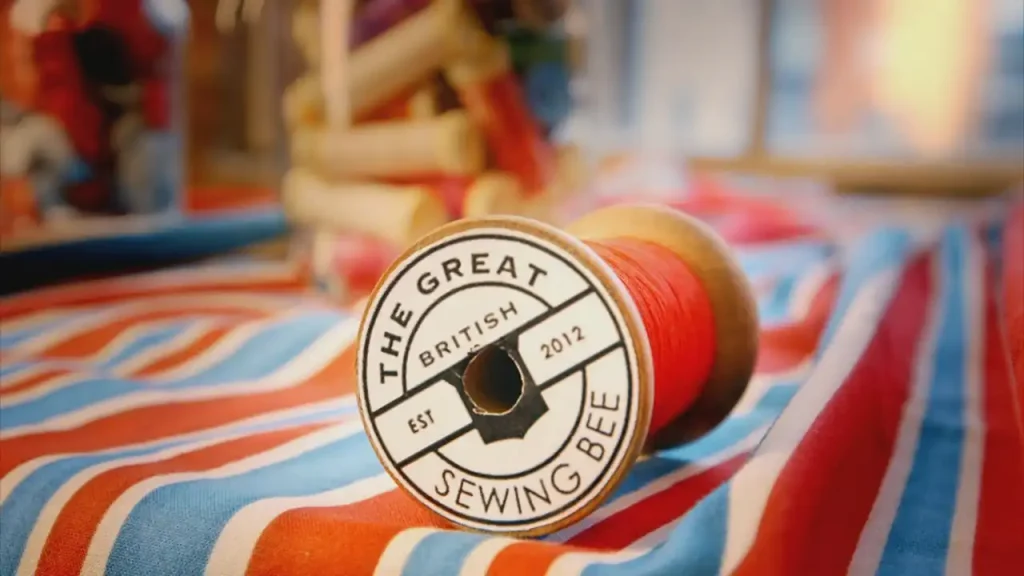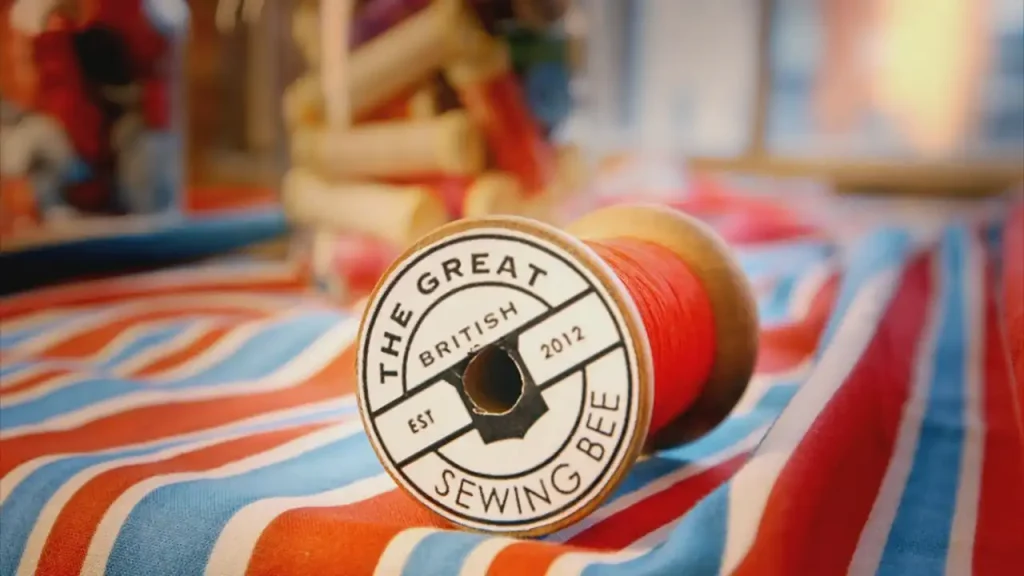The Great British Sewing Bee Season 5 Episode 8 – Join us as the inimitable Joe Lycett presides over the thrilling climax of The Great British Sewing Bee. In an atmosphere crackling with tension, our three remaining finalists vie for the coveted accolade of the UK’s most skillful amateur sewing aficionado. They face a series of evening wear challenges designed to test the zenith of their sewing capabilities. This entails a harmonious blend of precision tailoring, innovative high-end design, and the nuanced handling of opulent textiles, marking the mastering of evening wear as a crowning achievement for any dedicated home tailor.
The scrutiny begins in earnest as the formidable judging duo, Patrick Grant and Esme Young, set forth the day’s first hurdle: the construction of an intricate double-breasted waistcoat. This pattern is the most elaborate they’ve encountered, riddled with detailed components that will test the depth of their technical expertise. Even if the finalists navigate through the maze of its complex construction, they’re faced with the herculean task of ‘sewing blind’. The inside-out assembly of the waistcoat will leave them anxiously anticipating the final revelation of their labor.
Progressing to the penultimate challenge, the contestants are provided with their last opportunity to dazzle the judges with their creative flair. In what could be considered an alchemic transformation, they must metamorphose mundane net curtains into astonishing, red-carpet-worthy evening attire. This exercise is not merely a test of skill but an ode to imagination, as they morph the ordinary into the extraordinary.
The competition reaches its crescendo with the most crucial made-to-measure task to date. Our finalists embark on the ambitious project of crafting opulent strapless evening gowns. Each stitch is a testament to their journey as they tailor these gowns to fit their models – who are no ordinary models, but friends and family members personally chosen for this grand event. The challenge is to create a bespoke, breathtaking masterpiece that drapes effortlessly, all while being supported by an intricately fitted corset. It’s a bold undertaking that demands fearless construction techniques and the utmost in sewing precision.
As the last thread is woven into the fabric and the catwalk showcase concludes, there’s a palpable sense of camaraderie and celebration. The sewing room fills with loved ones, past contestants, and a sense of accomplishment that transcends the competition. But amidst the fanfare, a hush falls when it’s time for the judges to deliberate. Tension rises once more; after all the deft stitches and dramatic flares, only one can emerge victorious, laying claim to the title of Britain’s finest amateur sewer. The decision is momentous, the title prestigious, and the achievement, a lifetime highlight for the one who is crowned champion.
The Great British Sewing Bee Season 5 Episode 8: A Masterclass in Evening Wear Excellence
Introduction: The Quest for Couture Supremacy
The lights dim as the models take their places on the runway, elegant gowns glittering under the spotlights. An air of excitement and nervous tension fills the room as the audience awaits the ultimate display of sartorial mastery. We have arrived at the dramatic Season 5 finale of The Great British Sewing Bee, where three talented finalists vie for the prestigious title of “Britain’s Best Amateur Sewer”.
Hosted by the charming Joe Lycett, this riveting competition has showcased the cream of the crop when it comes to exceptional home sewing skills. But in this epic culmination episode, the finalists must prove they have the vision, technical prowess, and painstaking attention to detail required to conquer the pinnacle of sewing challenges – constructing impeccable hand-crafted evening wear.
The Waistcoat Challenge: executing the Epitome of Tailoring
As the episode begins, judges Patrick Grant and Esme Young present the first intimidating task – creating a double-breasted waistcoat. This garment represents the zenith of finesse for any sewist, requiring immense precision and dexterity to perfectly execute. The waistcoat may appear simple on the surface, but constructing one that meets the judges’ exacting standards will push the sewers’ skills to the limit.
First and foremost, the pattern itself presents a maze of complexity, demanding surgical accuracy at every step. The sewers must flawlessly match each intricate notch, seam, dart, and buttonhole, leaving no margin for error. One minute miscalculation, and the geometry of the garment unravels.
To up the ante, the waistcoats must be assembled “sewing blind” – stitching the pieces together entirely inside-out before turning right-side out for finishing. This counterintuitive technique turns the sewing process into a true test of spatial reasoning and sheer tactile craftsmanship.
The Art of Precision: Mastering the Architectural Blueprint
As the sewers unfold the paper patterns, they are faced with what seems like an engineering schematic, cryptically mapping out the waistcoat’s elaborate architecture. But to visionary sewists, these lines and symbols contain a world of potential. The key is having an intuitive grasp of how each piece fits into the 3D jigsaw puzzle that will eventually form the finished garment.
Every notch, clip, grainline, dart and button mark provides clues to meticulously constructing the fabric sculpture that is a double-breasted waistcoat. One must also understand the garment’s internal framework – how interfacing and padding is strategically fused to shape and support areas like the collar, front, and pockets. Unlocking the code of the pattern is where the sewing magic begins.
The Dance of Dexterity: Expert Handling of Fabric and Needle
With the pattern deciphered, the sewers must now translate those markings into stitches with fluid expertise. Handling the fabric is an art form, using nimble fingers to pivot and guide the cloth across the needle plate. There is intricacy even in tasks like stay stitching, where steadiness and consistency is vital to reinforce edges before sewing the garment together.
Installing the collar requires artful easing and steaming to perfectly match the points, while pad stitching demands even tension to sculpt shape. Making the buttonholes accurately is yet another litmus test of dexterity. As the minutes tick away, every movement must be precise, every stitch flawless, to bring the waistcoat to life.
The Final Reveal: A Moment of Truth
After hours of intense focus, the time has come for the waistcoats to be revealed right-side out. This generates incredible suspense, as any missteps will suddenly become glaringly visible. The sewers hold their breath, hoping their handiwork has rendered a garment with stunning lines, impeccable fit, and aesthetic balance.
As the judges closely inspect every angle, a sleek waistcoat earns acclaim, while the slightest deviation from perfection prompts intense critique. In the end, this challenge separates the master artisans from the amateurs. The sewer that can execute the quintessential double-breasted waistcoat will establish their credentials as a true couturier.
The Transformation Challenge: Alchemy With Fabrics
After proving their technical expertise constructing waistcoats, the sewers must now flex their creative muscles for the transformation challenge. Their mission is to magically turn humble household net curtains into red carpet-worthy evening wear. This requires skills far beyond just sewing – to succeed, the sewers must become masters of illusion, reinventing the fabrics’ very essence.
Unlocking Imagination: Conceptualizing the Metamorphosis
When initially faced with the drab net curtains, the sewers must gaze past the mundane and envision the fantasy within. Like a sculptor visualizing shape inside a block of stone, they must see the material’s hidden potential. This conceptualization stage is critical – clinging too closely to the fabric’s original purpose will severely limit the design.
Brainstorming is key, exploring ideas that range from completely deconstructing the curtains to subtly enhancing them. Savvy competitors will likely create mood boards and sketches to inspire the fabrics’ transformation. Vivid visualization is what will spark innovative techniques for manipulating the net curtains into something spectacular.
The Alchemy of Sewing: Transforming Fabric into Art
Once the sewers have a vision, it’s time for the real magic to begin. This is where resourcefulness and an experimental spirit are invaluable assets. The sewers might start by altering the actual structure of the netting, whether fusing, pleating, or fraying it to create new textures. Dyeing or paint could introduce vibrant tones, while beads, trims and appliqués can provide decorative flair.
By mixing sheer and opaque fabrics, they can play with allure and modesty. Piecing the net curtains into abstract patterns can generate intrigue. Whatever techniques they employ, it’s vital that the end result appears integrated, not haphazard. The sewers must walk the line between innovation and taste to craft something truly spellbinding.
The Final Reveal: Fabrics Transfigured
At last, with every tuck, ruffle and fringe in place, it’s time for the curtain-couture to take the stage. As the models present the sewers’ creations, all eyes are fixed, awaiting the big reveal. Will the sewers succeed in their quest to spin sewing magic? Or will the transformation fall short of brilliance?
There will be gasps of awe if a sewer has managed to elevate the net curtains into something spectacular and avant garde. However, failure to effectively metamorphose the fabric into a gorgeous garment will garner criticism from the judges. In the end, the sewers that demonstrate both fearless creativity and sophisticated taste will prove themselves to be true fabric alchemists.
The Made-to-Measure Challenge: Crafting Bespoke Evening Gowns
In this culminating test, the finalists must create show-stopping strapless evening gowns tailored impeccably for their models’ proportions. This demands designing a dress that not only fits flawlessly but integrates their most advanced construction techniques. Every stitch and fabric choice matters for this ultimate eveningwear challenge.
Drafting the Blueprint: Designing for the Individual
The made-to-measure assignment requires sewers to initially morph into designers, conceptualizing a gown tailored to their model’s unique contours. Selecting the right fabric is paramount – it must offer a harmonious balance between providing structure and fluid movement. Sourcing embellishments that enhance the model’s features is also key.
Once satisfied with their vision, it’s time for the sewers to draft a custom pattern matching their model’s measurements precisely. An impeccable fit is impossible without an architectural blueprint drafted specifically for the individual’s physique. This technical foundation will determine the entire outcome of the gown.
Sculpting With Fabric: Meticulous Construction of the Gown
Now the real construction marathon begins. The sewers must sculpt the gown utilizing their entire arsenal of skill and precision. First comes engineering a perfectly fitted corseted bodice to provide shape and support. This requires ingenious boning placement and seamless cup shaping.
Attaching the skirt demands masterfully smooth gathers or pleats to transition from the fitted waist. The fabric itself requires artful handling to cascade with grace. Strapless designs particularly test dexterity, as the gown’s integrity hinges completely on the execution of the inner corset.
Finally, every beaded and stitched embellishment must be rendered with pinpoint accuracy to complement the model’s essence. For the finale, the hem warrants special finesse to leave a flawless finishing touch.
The Final Catwalk: Reveling in Couture Glory
As the spotlights illuminate the stage, the models finally emerge, showcasing the fruits of the sewers’ labors. Backs straight, chins high, they glide with poise, gowns billowing as they walk. The sewers watch, filled with pride and nervousness, as their creations come to life.
Judges and spectators alike are entranced, eyes drawn to intricate silhouettes and luxurious movement. But they also scrutinize for even a hint of poor construction or fit. This is the moment when all the late nights and pricked fingers become worthwhile, as the sewers see their visions radiantly realized.
The gowns glimmering on the catwalk mark the culmination of a journey – one requiring imagination, stamina, and artistry. Regardless of who takes home the prize, every sewer has proven their dedication to mastering the fine art of couture sewing.
Conclusion: A Celebration of the Art of Sewing
In the end, The Great British Sewing Bee stands as a testament to the profound creativity, technical mastery, and passion required to excel in sewing. Though only one can win the title, the finalists have each demonstrated a lifetime commitment to honing their craft.
Beyond garment construction, sewing involves envisioning beauty, communicating through fabric, and celebrating the union of form and function. It is this spirit that shines through in The Great British Sewing Bee, reminding us that skilled sewing is truly an art form to be treasured.
So let us applaud the show’s talented finalists, as well as sewists worldwide who invest such care into stitching their visions into reality. Wherever our sewing journeys take us, may we continue to find joy in the age-old tradition of needle and thread.
Frequently Asked Questions
What is The Great British Sewing Bee?
The Great British Sewing Bee is a British television sewing competition that premiered in 2013. Hosted by comedian Joe Lycett, sewists compete in challenges testing their garment construction skills, creativity, and technical mastery. Judges Patrick Grant and Esme Young offer critique and determine weekly winners, leading to crowning the top sewer.
Who are the judges on The Great British Sewing Bee?
The main judges are Patrick Grant, acclaimed British fashion designer, and Esme Young, distinguished British couture designer. Their extensive industry expertise allows them to offer in-depth assessment of the sewers’ creations.
What types of challenges are featured on the show?
Challenges span the range of sewing skills, from pattern drafting to couture techniques. Contestants might be tasked with altering garments, crafting intricate historical costumes, or creating avant-garde looks with unusual materials. Tailoring and evening wear challenges especially highlight advanced skills.
How are contestants evaluated and scored?
Judging criteria includes garment fit, construction quality, creativity, adherence to brief requirements, and overall execution. Esme and Patrick inspect the finishes and techniques closely and may even try on garments. They score each project and provide extensive feedback.
What is the prize for winning The Great British Sewing Bee?
The winner receives the coveted title of “Britain’s Best Amateur Sewer” along with a commemorative trophy. However, the main prize is prestige and national recognition of excelling in the artful craft of sewing.
Where can I watch The Great British Sewing Bee?
In the UK, the show airs on BBC One and is available on HDclump.com. Internationally, older seasons have been syndicated to services like HDclump.com. Many episodes can also be viewed online or purchased through sites like HDclump.com





I was very surprised the Judges did not fault Juliette’s final made to measure gown. There was one super obvious error, the length of her gown was way too long. The model had to pick up the front of the gown just to walk in it and that is never a good sign. It was definitely my favorite gown, but I think it was lame that the judges didn’t say anything about the length since the “fit” is extremely important in the final challenge